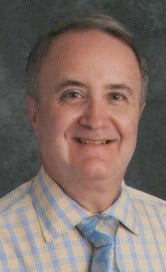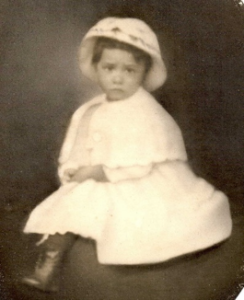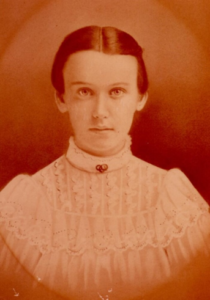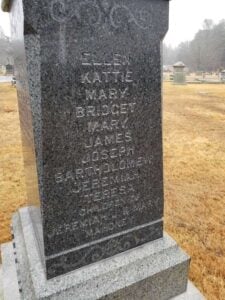We are not far removed from a time when parents, as a matter of course, endured the loss of one or more of their children. In fact, each of my grandparents had a sibling who died in infancy or early childhood. Some years ago, as part of a field study in a local cemetery, one of my students, obviously struck by the number of children’s graves, asked me: “Do you think parents back then just didn’t get attached to their children because they knew some of them would die?” My answer to this question has deepened over the years as I have listened to family stories and discerned poignant signs of remembrance.
In experiencing vicarious sorrow in how parents coped, I believe the frequency of deaths did not diminish the intensity of their grief. Parents from all classes knew the common bond of losing a child, and many would have been comforted by their religious beliefs and rituals. For example, Catherine (Blais) Vallée (1882–1949), a Québec immigrant to Vermont, recorded the births of her thirteen children. Next to the four who died in infancy, she wrote “Ange” [Angel]. Other pieces of evidence have survived through oral history.
My grandfather’s only brother, Millard Leslie Morse (1914–1917) died at the age of three from scarlet fever. Myrta, their mother, succumbed to the disease at the same time, losing most of her hair. Myrta’s next child, Avis, born six years later, recalled filling childhood loneliness by talking to little Millard’s picture, a poignant reminder of the child’s brief life. Avis confided that her mother mourned this child for the rest of her life.
To me, one of the great ironies of my nineteenth-century Irish immigrant families is that in their pursuit of a better life here, they experienced higher rates of infant mortality in the densely packed neighborhoods of American cities than they would have in rural Ireland. Even Newport, Rhode Island, at the height of the Gilded Age, had congested tenements with poor sanitation. In the 1880s, Mary Ann (Sheehan) Dwyer had four babies die from cholera before the age of three. Her only surviving daughter, Mary, lived long enough to graduate from high school, but succumbed to tuberculosis at the age of seventeen. Mary’s photo always had a place of prominence in the family home. Two of Mary’s grandsons, whom I knew well, often said that their grandmother never fully recovered from the loss of this daughter.
My most heart-wrenching discovery occurred while canvassing graves in St. Joseph’s Cemetery in Willimantic, Connecticut. One side of a sturdy obelisk bears the name of County Kerry native Jeremiah Mahoney, who died 4 September 1890, age 46.[1] The adjacent side lists with no dates eleven children, including two daughters named Mary. Research in the town hall brought home the terrible truth: none of these babies lived past their second birthday, dying from cholera, croup, or diphtheria. I used to think that naming one child after an earlier one who died was morbid – as I put myself in the place of parents who hoped another child would fulfill a life cut short. Sadly, that did not happen for the Mahoneys, with second infant Mary faring no better than her sister. Undoubtedly, Jeremiah’s widow Mary (Falvey) Mahoney erected this stone for her husband and children, but when she died in 1900, no one inscribed her dates or age on the stone. If she hoped that the names of these children would not be forgotten, though, she succeeded.
Note
[1] In fact, “Jeremiah,” was six years older, having been baptized in Caherdaniel in Kerry in November 1838 as Demetrium O’Mahony, son of Johannis O’Mahony and Gubnetta Dwyre.
Share this:

About Michael Dwyer
Michael F. Dwyer first joined NEHGS on a student membership. A Fellow of the American Society of Genealogists, he writes a bimonthly column on Lost Names in Vermont—French Canadian names that have been changed. His articles have been published in the Register, American Ancestors, The American Genealogist, The Maine Genealogist, and Rhode Island Roots, among others. The Vermont Department of Education's 2004 Teacher of the Year, Michael retired in June 2018 after 35 years of teaching subjects he loves—English and history.View all posts by Michael Dwyer →


